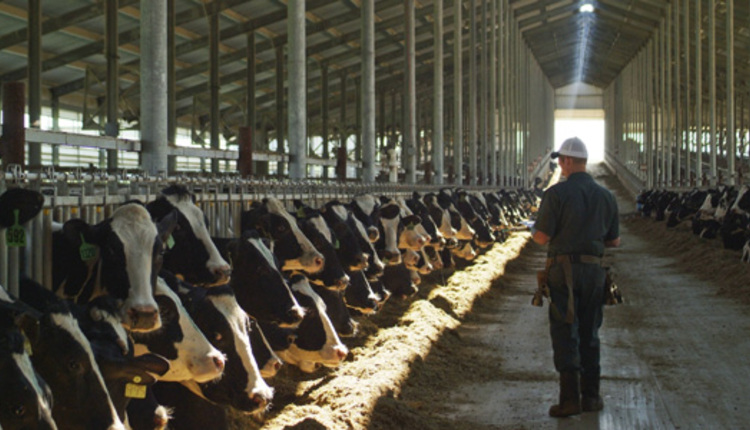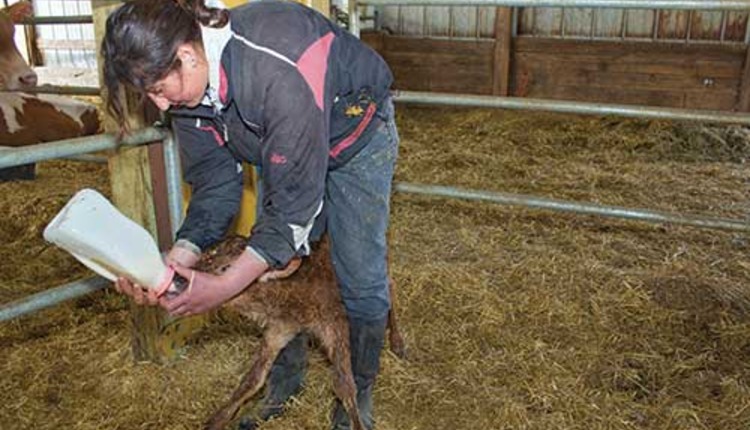Höglund is an adjunct assistant professor at the college of veterinary medicine at North Carolina State University. Beaver, a board certified veterinary behaviorist and executive director of the American College of Veterinary Behaviorists, is a professor of veterinary medicine at Texas A&M University.
The emphasis of dairy stockmanship training has always been on humane handling of cattle, and with that comes a secondary benefit - enhanced safety on the farm. Little did we know just how significant the human safety component would become. In 2009, David Douphrate from Colorado State University reported that more than one-half of on-farm injuries occur in and around the milking parlor.
Stockmanship is generally used to refer to the knowledge and skill a person has for handling livestock in an efficient, safe and low-energy way. To meet that need in the dairy industry, DairyStockmanship.com was formed by Paul Rapnicki, D.V.M., and Don Höglund, D.V.M. It was intended to be an on-farm education and training entity that coupled educational modules and hands-on training for all staff and management, with published articles in Hoard's Dairyman.
Training pays dividends
The concepts of handling contained within the dairy stockmanship course were first introduced to Hilmar Cheese Company and their contributing dairies in April 2012. Last year, we presented the welfare and well-being merits of dairy handling to another 100 milk suppliers in California and Texas.
Hilmar Cheese Company, Hilmar, Calif., produces more cheese annually from one site than any other manufacturer in the world. They receive over 21 million pounds of milk each day from more than 230 dairies and make 2.4 million pounds of cheese daily.
This organization has seen the effect humane handling can have on the dairies in which they interact. In addition to the benefits proper handling affords the cows, Hilmar dairy producers provide a safer, more productive working environment for their employees.
Low-energy cattle handling allows everyone to think through the process instead of reacting to the situation. The safety outcomes have been substantial. As Frank Dinis, manager of Charles Ahlem Ranch, pointed out, "Human and animal safety is a program that is built into the dairy operating structure here," said Dinis. "But much like a ladder has rungs or steps, we always begin climbing a ladder from the bottom up. Missing rungs means missteps and unsafe practices can result."
Injuries drop by half
Dinis also noted the success of the training. "On dairies where personnel were trained, we saw a 50 percent reduction in worker injuries. It breaks down barriers and provides a knowledge base that allows employees to buy-in and become good cow handlers. It's not the animal's fault when things are going wrong, it's the handler. The training also translates to other areas on the dairy."
Alec Brown of Chuck Ahlem Dairy noted that, "The training program, combined with a strong focus on safety, will greatly reduce the frequency and severity of animal-based injuries on dairies."
Brown went on to point out that, "After our formal stockmanship training program started, our company's loss ratio dropped drastically, which will substantially reduce our workers' compensation premium costs over the next few years. Stockmanship brings about both the awareness and the knowledge of what it takes to handle large animals safely. The on-farm training teaches an employee how his or her behavior affects cows and what can cause a cow to panic. Therefore, the employee will be looking for these things, thinking ahead and will be prepared."
Outside the classroom
Dairy Stockmanship is not just a handling seminar. It is a life-cycle series - a practical, on-farm, education platform to teach staff how animals will respond to a human's presence and react in the existing environment. It begins with a training module for self-paced classroom education in each key area on the dairy. This is followed by a structured, closely-managed hands-on training, in the pen or along the way to the milking parlor led by educators from the program.
Dinis noted, "Our handlers spend the day working directly with animals. They need formal training that is both safe and fast," he noted. "Traditional on-the-job classroom training takes a long time, depending on the individual. There is a higher risk of injury when staff start work before understanding how to actually handle the live animals properly. As we see it, a secondary benefit is that animals are trained simultaneously.
"After the classroom education each morning, we head to the pens and teach hand-eye coordination, train in muscle memory and rehearse each prior day's key points.
"We all become teachers, and that is where ownership can see leadership evolve in their future managers. Along the way, we teach flow applications for the design of dairy and beef cattle facilities, the effect of adrenaline on milk production, and all of it is intended as a bridge to help aid in the education and handling training needs of all dairies."
Click here to return to the Animal Care E-Sources
140325_232
The emphasis of dairy stockmanship training has always been on humane handling of cattle, and with that comes a secondary benefit - enhanced safety on the farm. Little did we know just how significant the human safety component would become. In 2009, David Douphrate from Colorado State University reported that more than one-half of on-farm injuries occur in and around the milking parlor.
Stockmanship is generally used to refer to the knowledge and skill a person has for handling livestock in an efficient, safe and low-energy way. To meet that need in the dairy industry, DairyStockmanship.com was formed by Paul Rapnicki, D.V.M., and Don Höglund, D.V.M. It was intended to be an on-farm education and training entity that coupled educational modules and hands-on training for all staff and management, with published articles in Hoard's Dairyman.
Training pays dividends
The concepts of handling contained within the dairy stockmanship course were first introduced to Hilmar Cheese Company and their contributing dairies in April 2012. Last year, we presented the welfare and well-being merits of dairy handling to another 100 milk suppliers in California and Texas.
Hilmar Cheese Company, Hilmar, Calif., produces more cheese annually from one site than any other manufacturer in the world. They receive over 21 million pounds of milk each day from more than 230 dairies and make 2.4 million pounds of cheese daily.
This organization has seen the effect humane handling can have on the dairies in which they interact. In addition to the benefits proper handling affords the cows, Hilmar dairy producers provide a safer, more productive working environment for their employees.
Low-energy cattle handling allows everyone to think through the process instead of reacting to the situation. The safety outcomes have been substantial. As Frank Dinis, manager of Charles Ahlem Ranch, pointed out, "Human and animal safety is a program that is built into the dairy operating structure here," said Dinis. "But much like a ladder has rungs or steps, we always begin climbing a ladder from the bottom up. Missing rungs means missteps and unsafe practices can result."
Injuries drop by half
Dinis also noted the success of the training. "On dairies where personnel were trained, we saw a 50 percent reduction in worker injuries. It breaks down barriers and provides a knowledge base that allows employees to buy-in and become good cow handlers. It's not the animal's fault when things are going wrong, it's the handler. The training also translates to other areas on the dairy."
Alec Brown of Chuck Ahlem Dairy noted that, "The training program, combined with a strong focus on safety, will greatly reduce the frequency and severity of animal-based injuries on dairies."
Brown went on to point out that, "After our formal stockmanship training program started, our company's loss ratio dropped drastically, which will substantially reduce our workers' compensation premium costs over the next few years. Stockmanship brings about both the awareness and the knowledge of what it takes to handle large animals safely. The on-farm training teaches an employee how his or her behavior affects cows and what can cause a cow to panic. Therefore, the employee will be looking for these things, thinking ahead and will be prepared."
Outside the classroom
Dairy Stockmanship is not just a handling seminar. It is a life-cycle series - a practical, on-farm, education platform to teach staff how animals will respond to a human's presence and react in the existing environment. It begins with a training module for self-paced classroom education in each key area on the dairy. This is followed by a structured, closely-managed hands-on training, in the pen or along the way to the milking parlor led by educators from the program.
Dinis noted, "Our handlers spend the day working directly with animals. They need formal training that is both safe and fast," he noted. "Traditional on-the-job classroom training takes a long time, depending on the individual. There is a higher risk of injury when staff start work before understanding how to actually handle the live animals properly. As we see it, a secondary benefit is that animals are trained simultaneously.
"After the classroom education each morning, we head to the pens and teach hand-eye coordination, train in muscle memory and rehearse each prior day's key points.
"We all become teachers, and that is where ownership can see leadership evolve in their future managers. Along the way, we teach flow applications for the design of dairy and beef cattle facilities, the effect of adrenaline on milk production, and all of it is intended as a bridge to help aid in the education and handling training needs of all dairies."
140325_232










